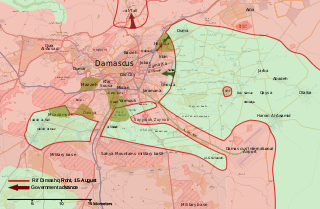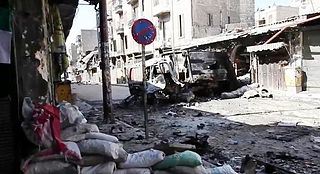
Saraqib is a city in northwestern Syria, administratively belonging to the Idlib Governorate, located east of Idlib. During the course of the Syrian Civil War, the city fell into rebel forces in 2012 and was recaptured by the Syrian Army in 2020.

The Free Syrian Army (FSA) is a loose faction in the Syrian Civil War founded on 29 July 2011 by officers of the Syrian Armed Forces whose goal is to bring down the government of Bashar al-Assad. A formal organization at its founding, its structure gradually dissipated by late 2012, and the FSA identity has since been used by various opposition groups.

This is a broad timeline of the course of major events of the Syrian civil war. It only includes major territorial changes and attacks and does not include every event.

The 2012 Aleppo Governorate clashes were a series of battles as part of the early insurgency phase of the Syrian civil war in the Aleppo Governorate of Syria.
The following is a timeline of the Syrian Civil War from January to April 2012, during which time the spate of protests that began in January 2011 lasted into another calendar year. An Arab League monitoring mission ended in failure as Syrian troops and anti-government militants continued to do battle across the country and the Syrian government prevented foreign observers from touring active battlefields, including besieged opposition strongholds. A United Nations-backed ceasefire brokered by special envoy Kofi Annan met a similar fate, with unarmed UN peacekeepers' movements tightly controlled by the government and fighting.
The following is a timeline of the Syrian Civil War from May to August 2012. The majority of death tolls reported for each day comes from the Local Coordination Committees, an opposition activist group based in Syria, and the Syrian Observatory for Human Rights, another opposition group based in London.

The Battle of Damascus, also known as Operation Damascus Volcano, started on 15 July 2012 during the Syrian Civil War. It is unclear who started the battle. Thousands of rebels infiltrated Damascus from the surrounding countryside. Following this, according to some reports, the opposition forces launched an operation to capture the capital, while according to other reports, the military learned of the large-scale rebel operation beforehand and made a preemptive strike. Some reports even suggested the rebels launched the operation prematurely due to their plans being discovered by the security forces.

The Battle of Aleppo was a major military confrontation in Aleppo, the largest city in Syria, between the Syrian opposition against the Syrian government, supported by Hezbollah, Shia militias and Russia, and against the Kurdish-majority People's Protection Units (YPG). The battle began on 19 July 2012 and was part of the ongoing Syrian Civil War. A stalemate that had been in place for four years finally ended in July 2016, when Syrian government troops closed the rebels' last supply line into Aleppo with the support of Russian airstrikes. In response, rebel forces launched unsuccessful counteroffensives in September and October that failed to break the siege; in November, government forces embarked on a decisive campaign that resulted in the recapture of all of Aleppo by December 2016. The Syrian government victory is widely seen as a turning point in Syria's civil war.
This page provides maps and a list of cities and towns during the Syrian civil war.

Darat Izza is a town in northern Syria, administratively part of the Aleppo Governorate, located 30 kilometres northwest of Aleppo. Nearby localities include Deir Samaan to the north, Anadan to the east and Turmanin to the southwest.

The Rif Dimashq offensive was a Syrian Army offensive in the Rif Dimashq Governorate during August–October 2012, as part of the Syrian Civil War.
The following is a timeline of the Syrian Civil War from September to December 2012. Information about aggregated casualty counts is found at Casualties of the Syrian Civil War.
The following is a timeline of the Syrian Civil War from January to April 2013. Information about aggregated casualty counts is found at Casualties of the Syrian Civil War.

The June 2012–April 2013 Idlib Governorate clashes was a series of clashes within the scope of the Syrian civil war, that took place in Syria's Idlib Governorate. The events followed the April 2012 Idlib Governorate Operation by the Syrian government and consequent cease-fire attempt, which had lasted from 14 April to 2 June 2012.
The following is a timeline of the Syrian Civil War from August to December 2014. Information about aggregated casualty counts is found at Casualties of the Syrian Civil War.
The following is a timeline of the Syrian Civil War from January to July 2015. Information about aggregated casualty counts is found at Casualties of the Syrian Civil War.
The following is a timeline of the Syrian Civil War from August to December 2015. Information about aggregated casualty counts is found at Casualties of the Syrian Civil War.
The following is a timeline of the Syrian Civil War from January to April 2016. Information about aggregated casualty counts is found at Casualties of the Syrian Civil War.

The 2012–2013 escalation of the Syrian Civil War refers to the third phase of the Syrian Civil War, which gradually escalated from a UN-mediated cease fire attempt during April–May 2012 and deteriorated into radical violence, escalating the conflict level to a full-fledged civil war.








